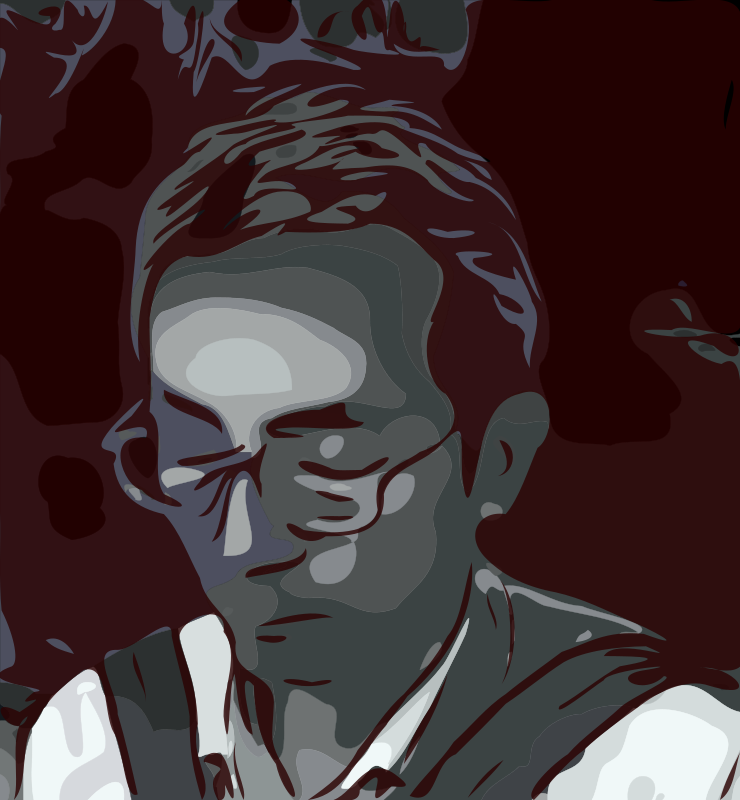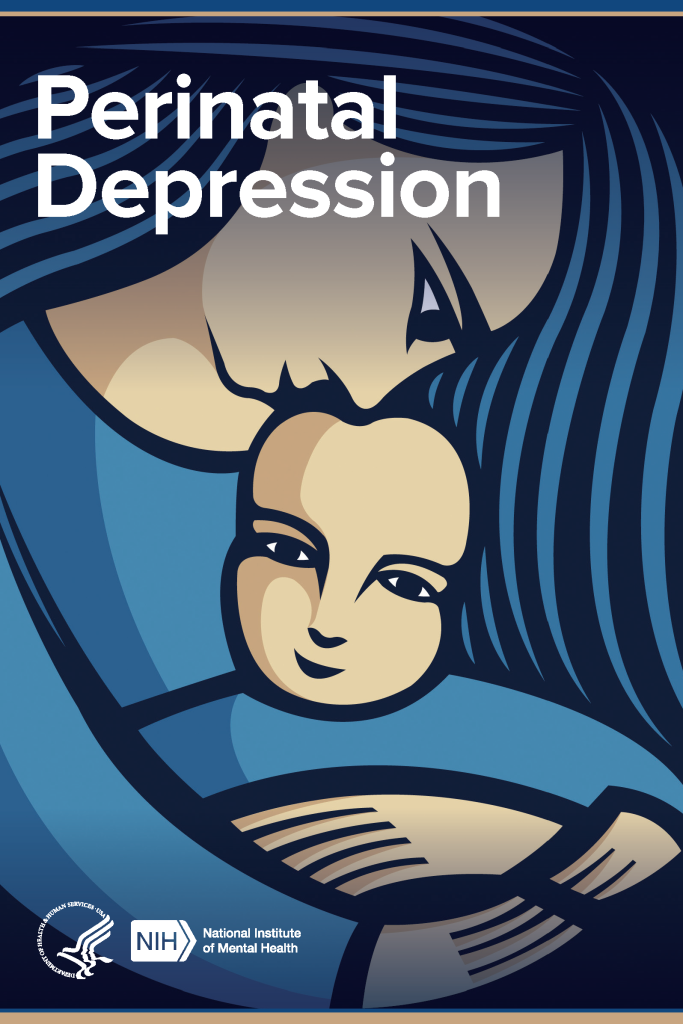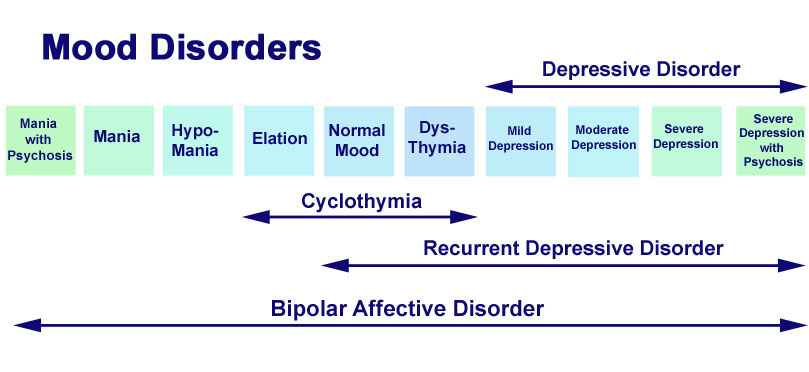Depression is different from the usual mood fluctuations and short-lived emotional responses to everyday life stressors. When it is recurrent with moderate or severe intensity, depression can become a serious health condition that causes the affected person to suffer greatly and function poorly at work and school and can affect relationships with family and friends. At its worst, depression can lead to suicide. Over 700,000 people die every year due to suicide. Barriers to effective care for depression include a lack of resources, lack of trained health care providers, and social stigma associated with mental health disorders.[1] See Figure 7.5[2] for an artistic depiction of an individual experiencing depression.

During a depressive episode, the person experiences a depressed mood (feeling sad, irritable, empty) or a loss of pleasure or interest in activities (anhedonia) for most of the day, nearly every day, for at least two weeks. Several other symptoms may also be present, which may include poor concentration, feelings of excessive guilt or low self-worth, hopelessness about the future, thoughts about dying or suicide, disrupted sleep, changes in appetite or weight, and feeling especially tired or low in energy. In some cultural contexts, some people may express their mood changes more readily in the form of bodily symptoms (such as pain, fatigue, or weakness) that are not due to another medical condition. During a depressive episode, the person experiences significant difficulty and/or impairment in important areas of personal, family, social, educational, and work functioning.[3]
A depressive episode is categorized by a provider as mild, moderate, or severe depending on the number and severity of symptoms, as well as the impact on the individual’s functioning.[4] Mild severity indicates the symptoms to make the diagnosis are present but result in minor impairment in social or occupational functioning. Moderate severity indicates symptoms and impairment are between mild and severe. Severe indicates the intensity is seriously distressing, unmanageable, and markedly interferes with social and occupational functioning. Read the full list of criteria for Major Depressive Disorder from the DSM-5 in the following box.
DSM-5 Criteria for Major Depressive Disorder[5]
- Five or more of the following symptoms have been present during the same two-week period and represent a change from previous functioning; at least one of the symptoms is either (1) depressed mood or (2) loss of interest or pleasure.
- Depressed mood most of the day, nearly every day, as indicated by either subjective report (e.g., feels sad, empty, hopeless) or observation made by others (e.g., appears tearful). (Note: In children and adolescents, can be irritable mood.)
- Markedly diminished interest or pleasure in all, or almost all, activities most of the day, nearly every day.
- Significant weight loss when not dieting or weight gain (i.e., a change of more than 5% of body weight in a month) or decrease or increase in appetite nearly every day. (Note: In children, consider failure to make expected weight gain.)
- Insomnia or hypersomnia nearly every day.
- Psychomotor agitation or retardation nearly every day (observable by others, not merely subjective feelings of restlessness or being slowed down).
- Fatigue or loss of energy nearly every day.
- Feelings of worthlessness or excessive or inappropriate guilt (which may be delusional) nearly every day (not merely self-reproach or guilt about being sick).
- Diminished ability to think or concentrate, or indecisiveness, nearly every day (either by subjective account or as observed by others).
- Recurrent thoughts of death (not just fear of dying), recurrent suicidal ideation without a specific plan, or a suicide attempt or a specific plan for committing suicide.
- The symptoms cause clinically significant distress or impairment in social, occupational, or other important areas of functioning.
- The episode is not attributable to the physiological effects of a substance or another medical condition.
According to the DSM-5, the types of depressive disorders include the following[6]:
- Major Depressive Disorder: Five or more symptoms are present during the same two-week period and represent a change from previous functioning and at least one of the symptoms is depressed mood or loss of interest or pleasure. Read the symptoms of depression in the previous box.
- Specifiers may be attached to the diagnosis such as:
- With anxious distress (tense and/or restless)
- With mixed features (manic symptoms)
- With psychotic features (delusions and/or hallucinations)
- With peripartum onset (includes perinatal and postpartum depression)
- With a seasonal pattern (includes seasonal affective disorder)
- Specifiers may be attached to the diagnosis such as:
- Persistent Depressive Disorder (Dysthymia): Depressed mood for most of the day for at least two years.
- Premenstrual Dysphoric Disorder: In the majority of menstrual cycles, at least five symptoms are present in the week before the onset of menses, start to improve after the onset of menses, and become minimal or absent in the week postmenses.
- Substance/Medication-Induced Depressive Disorder: A persistent disturbance in mood that develops during or soon after substance intoxication or during withdrawal from a substance.
- Depressive Disorder Due to Another Medical Condition: A persistent period of depressed mood that is the direct consequence of another medical condition.
Seasonal Affective Disorder
Seasonal affective disorder (SAD) is a type of major depressive disorder that affects about 5% of adults in the United States. People with SAD experience mood changes and symptoms similar to depression. The symptoms usually occur during the fall and winter months when there is less sunlight and usually improve with the arrival of spring. SAD is more than just “winter blues.” The symptoms can be distressing and overwhelming and can interfere with daily functioning.[7]
SAD has been linked to a biochemical imbalance in the brain prompted by shorter daylight hours and less sunlight in winter. As seasons change, people experience a shift in their biological internal clock or circadian rhythm that can cause them to be out of step with their daily schedule. SAD is more common in people living far from the equator where there are fewer daylight hours in the winter.[8]
SAD can be effectively treated with light therapy, antidepressant medications, cognitive behavioral therapy, or some combination of these. While symptoms will generally improve on their own with the change of season, symptoms can improve more quickly with treatment. Light therapy involves sitting in front of a light therapy box that emits a very bright light (and filters out harmful ultraviolet [UV] rays). It usually requires 20 minutes or more per day, typically first thing in the morning during the winter months. Most people see some improvements from light therapy within one or two weeks of beginning treatment. For some people, increased exposure to natural sunlight can help improve symptoms of SAD by spending time outside or arranging their home or office space to increase exposure to windows during daylight hours. General wellness activities such as performing regular exercise, eating healthfully, getting enough sleep, and staying active and connected (such as volunteering, participating in group activities and getting together with friends and family) can also help.[9]
Peripartum Depression
Pregnancy and the period after delivery can be a vulnerable time for women. Mothers can experience significant biological, emotional, financial, and social changes during this time. Up to 70 percent of new mothers experience the “baby blues,” a short-term condition that does not interfere with their daily activities and does not require medical attention. Symptoms include crying for no reason, irritability, restlessness, and anxiety. These symptoms generally last up to two weeks and resolve on their own.[10]
However, as many as 3 to 6% of women experience a type of major depressive disorder during pregnancy (called perinatal depression) or after delivery (called postpartum depression).[11] See Figure 7.6[12] for an illustration of perinatal depression from the National Institutes of Health.
Postpartum depression includes feelings of extreme sadness, anxiety, and exhaustion that may make it difficult for these new mothers to complete daily care activities for themselves and/or for their babies. Untreated peripartum depression is not only a problem for the mother’s health and quality of life but can also affect the well-being of the baby. Postpartum depression can cause bonding issues with the baby and also contribute to sleeping and feeding problems for the baby. In the long-term, children of mothers with peripartum depression are at greater risk for cognitive, emotional, developmental and verbal deficits, and impaired social skills.[13]
Severe postpartum depression can lead to postpartum psychosis, a medical emergency. Women who have postpartum psychosis may have delusions (thoughts or beliefs that are not true), hallucinations (seeing, hearing, or smelling things that are not there), mania (a high, elated mood that often seems out of touch with reality), paranoia, and confusion. Women who have postpartum psychosis are at risk for harming themselves or their child and should receive help as soon as possible by calling 911 or taking the mother to the nearest emergency room.

Read more information about perinatal depression on the National Institute of Mental Health’s Perinatal Depression webpage.
View the following YouTube video on postpartum depression from the National Institute of Mental Health[14]: PostPartum Depression
Mixed Features
Depressive episodes can also be classified as “mixed,” meaning they alternate with periods of manic symptoms such as euphoria, irritability, increased activity, increased talkativeness, racing thoughts, increased self-esteem, decreased need for sleep, distractibility, and impulsive reckless behavior.[15] Characteristics and treatment of bipolar disorder are further discussed in the “Bipolar Disorders” chapter. See Figure 7.7[16] for a comparison of the features of different types of mood disorders.

Read more information at the American Psychiatric Association’s What is Depression? webpage.
Listen to The Dark Place podcast on the Podbean website to hear personal perspectives on depression and other mental health topics.
View the following YouTube video of an advocate explaining her experiences with depression and her journey to recovery[17]:
Depression Associated With Grief
People have difficulty coping with the death or loss of a loved one, job, or relationship. It is normal for feelings of sadness or grief to develop in response to such situations, but being sad is not the same as having depression. The grieving process is natural and unique to each individual and shares some of the same features of depression. Both grief and depression can involve intense sadness and withdrawal from usual activities with increased risk for suicide.
According to the American Psychiatric Association, grief and depression are different in these ways[18]:
- In grief, painful feelings come in waves, often intermixed with positive memories of the deceased. In major depression, mood and/or interest (pleasure) are decreased for most of two weeks.
- In grief, self-esteem is usually maintained. In major depression, feelings of worthlessness and self-loathing are common.
- In grief, thoughts of death may surface when thinking of or fantasizing about “joining” the deceased loved one. In major depression, thoughts are focused on ending one’s life due to feeling worthless or undeserving of living or being unable to cope with the pain of depression.
Grief and depression can coexist. When grief and depression occur together, the grief is more severe and lasts longer than grief without depression. Nurses must be able to distinguish between symptoms of grief and depression and assist people in getting the help, support, or treatment they need.[19]
Read more information about grief in the “Grief and Loss” chapter in Open RN Nursing Fundamentals.
- World Health Organization. (2021, September 13). Depression. https://www.who.int/news-room/fact-sheets/detail/depression ↵
- “320531.png” by j4p4n at openclipart.org is licensed in the Public Domain. ↵
- World Health Organization. (2021, September 13). Depression. https://www.who.int/news-room/fact-sheets/detail/depression ↵
- World Health Organization. (2021, September 13). Depression. https://www.who.int/news-room/fact-sheets/detail/depression ↵
- Schreiber, J., & Culpepper, L. (2021). Suicidal ideation and behavior in adults. UpToDate. Retrieved November 16, 2021, from https://www.uptodate.com/ ↵
- American Psychiatric Association. (2013). Desk reference to the diagnostic criteria from DSM-5. ↵
- American Psychiatric Association. (2020). Seasonal affective disorder (SAD). https://www.psychiatry.org/patients-families/depression/seasonal-affective-disorder ↵
- American Psychiatric Association. (2020). Seasonal affective disorder (SAD). https://www.psychiatry.org/patients-families/depression/seasonal-affective-disorder ↵
- American Psychiatric Association. (2020). Seasonal affective disorder (SAD). https://www.psychiatry.org/patients-families/depression/seasonal-affective-disorder ↵
- American Psychiatric Association (2020). What is peripartum depression (formerly postpartum)? https://www.psychiatry.org/patients-families/postpartum-depression/what-is-postpartum-depression ↵
- American Psychiatric Association. (2013). Desk reference to the diagnostic criteria from DSM-5. ↵
- This image is a derivative of “20-mh-8116-perinataldepression.pdf” by National Institute of Mental Health and is licensed in the Public Domain. Access for free at https://www.nimh.nih.gov/health/publications/perinatal-depression. ↵
- American Psychiatric Association (2020, October). What is peripartum depression (formerly postpartum)? https://www.psychiatry.org/patients-families/postpartum-depression/what-is-postpartum-depression ↵
- National Institute of Mental Health. (2016, April 19). Postpartum Depression. [Video]. YouTube. All rights reserved. https://youtu.be/zbUl2hZNlKY ↵
- World Health Organization. (2021, September 13). Depression. https://www.who.int/news-room/fact-sheets/detail/depression ↵
- “mood-disorders.jpg” by Dr. Vipul Rastogi, MBBS; DCP (Ireland); MRCPsych (UK) Speciality Registrar, Hampshire Partnership Trust, UK for www.clinicaljunior.com. Image used under Fair Use. Access for free at http://www.clinicaljunior.com/psychmoodvipul.html ↵
- World Health Organization (WHO). (2018, September 19). Youth voices: Kylie Verzosa on depression [Video]. YouTube. Licensed in the Public Domain. https://youtu.be/tRc4XZXYTgY ↵
- American Psychiatric Association. (2020). What is depression? https://www.psychiatry.org/patients-families/depression/what-is-depression ↵
- American Psychiatric Association. (2020). What is depression? https://www.psychiatry.org/patients-families/depression/what-is-depression ↵
An episode where the person experiences a depressed mood (feeling sad, irritable, empty) or a loss of pleasure or interest in activities, for most of the day, nearly every day, for at least two weeks.
A type of depression causing symptoms during the fall and winter months when there is less sunlight and usually improves with the arrival of spring.
Therapy for seasonal affective disorder (SAD) that involves sitting in front of a light therapy box that emits a very bright light. It usually requires 20 minutes or more per day, typically first thing in the morning, during the winter months.
Depressive disorder that occurs during pregnancy.
Feelings of extreme sadness, anxiety, and exhaustion that may make it difficult for mothers of newborns to complete daily care activities for themselves and/or for their babies.
Severe postpartum depression can cause delusions (thoughts or beliefs that are not true), hallucinations (seeing, hearing, or smelling things that are not there), mania (a high, elated mood that often seems out of touch with reality), paranoia, and confusion.

